|
July 29, 2021
Dear Neighbors and Friends,
I hope that you and your loved ones are doing well, staying healthy, and looking out for your neighbors and friends during this past week.
It has again been a difficult one on the COVID front. This weekly snapshot allows us to see the impact that COVID’s Delta variant is having on us here in Oregon, as it is everywhere in the U.S. right now, with its deadliest effects among those who have not been vaccinated against the virus. Case rates and hospitalization rates have doubled, test positivity rates are high, and we have to expect we’ll be seeing substantial increases in deaths soon. (Increases in death rates are lagging indicators and will continue to rise even after the case rates have started to decline.) Particularly concerning is the highest number of outbreaks that we’ve seen in congregate care facilities since mid-May and the stresses that we’re beginning to see in our hospital capacity.
This week’s county report, weekly data report, outbreak report, the graphs, and the various linked news articles unfortunately all point in the same troubling direction. When we’ve seen similar increases in the past, they’ve all led to a return to restrictions. That probably won’t happen this time, with more than two-thirds of adult Oregonians now vaccinated. Still, the Delta variant is proving itself to be exceptionally easy to spread, apparently even by people who have been vaccinated and are not themselves displaying symptoms, so there is reason for caution—and consideration of masking and vaccine employment mandates, subjects fraught with controversy. You’ll find more on that further down.
Next week’s newsletter will coincide with the state’s monthly breakthrough report, which will let us know the infection, hospitalization, and death rate among those who have been fully vaccinated. Hospitalization and death rates among those who’ve been vaccinated is something that the CDC is tracking (severe cases remain rare among the vaccinated), but they are not tracking those who’ve been infected with mild or asymptomatic cases—though many are calling on them to return to doing so. Next week’s Oregon breakthrough report will include information among all three.
Tonight’s newsletter also includes an update on wildfires here in Oregon, information on efforts to deal with the current heat wave and avoid the tragic consequences of the last one, and another lookback at the legislative session—this time focusing on new investments in mental/behavioral health.
Until next week, please stay healthy and safe, and let me know if you have any questions about information in tonight’s newsletter.
TODAY’S CORONAVIRUS AND CORONAVIRUS RESPONSE UPDATE
-
New COVID Cases: OHA reports 1,026 new COVID cases today (vs. 322 last Thursday). That’s an average of 638 per day for the 7 days since the last newsletter (252 more per day than the previous week). The cumulative number of cases in Oregon since the beginning of the pandemic is 218,689.
-
Variant COVID Cases: Here are this week’s updated case counts for the COVID variants in Oregon (released yesterday), cumulative from the beginning of the pandemic. You’ll see that the number of cases of the delta variant have again doubled (for the second week in a row). Be advised, though, that not all positive tests are being sequenced for variants, so the numbers are likely higher.
- 2,322 (up from 2,154) cases of the B.1.1.7 (formerly known as the U.K. variant, now called the Alpha) variant,
- 583 cases (up from 568) of the P.1 (formerly Brazilian, now Gamma) variant,
- 188 (up from180) cases of the B.1.351 (formerly South African, now Beta) variant.
- 179 cases (up from 90) cases of the new B.1.617.2 (Delta) variant.
- In addition, we are now seeing 1,200 (up from 1,184) cases of the combined B.1.427/B.1.429 variant (Epsilon). This is no longer considered a “variant of concern.” It is now considered a “variant of interest.”
- OHA’s Variant Dashboard also providing current variant case numbers for different parts of the state. It’s updated each Wednesday.
-
Positive Test Results: OHA reported 1,146 positive tests today (320 more than a week ago). That’s an average of 778 per day for the seven days since the last newsletter (301 more per day than the previous week). The cumulative total of positive test results since the beginning of the pandemic is now 315,396.
-
Total Tests: OHA reported an additional 12,930 tests today (vs. 12,207 a week ago). That’s an average of 11,721 per day for the seven days since the last newsletter (2,508 more per day than the last newsletter). Our cumulative total of reported tests is 5,689,339.
-
Positivity Rate: The test positivity ratio for Oregon today is 8.9% (vs. 6.8% a week ago and 4.2% the Thursday before that). That’s an average of 6.7% per day for the seven days since the last newsletter (vs. 5.1% per day for the previous week).
-
Hospitalization Information:
- Patients Currently with Confirmed COVID-19: 285 (134 more than last newsletter)
- ICU Patients Confirmed w COVID-19: 84 (47 more than last newsletter).
- Available ICU Beds: 94 (31 fewer than last newsletter)
- Other Available Beds: 394 (38 fewer than last newsletter).
- Confirmed COVID-19 Patients Currently on Ventilators: 39 (23 more than last newsletter)
- Available Ventilators: 776 (13 fewer than last newsletter).
-
Deaths: I’m sorry to report 6 additional COVID death today, which is 5 more than last Thursday. That’s an average of 3 per day for the week since the last newsletter (vs. 3.4 per day the previous week). The total number of COVID deaths in Oregon is 2,855.
-
Vaccinations:
- The 7-day running average is now 4,635 doses per day (up 59 from last week).
- Total First and Second Doses Administered So Far: 4,617,845
- 2,652,653 Pfizer doses
- 1,782,367 Moderna doses
- 180,441 Johnson & Johnson doses
- Total Oregonians vaccinated so far: 2,482,028
- 2,2305,579 now fully vaccinated with two doses
- To date, 5,611,075 doses of vaccine have been delivered to sites across Oregon. (That’s 34,190 more than last week.)
- 82.3% of these doses have been administered so far. The national average is now 86.7%.
- 60.5% of Oregonians have received at least one dose (68.7% of those 18 and older).
- 55.8% of Oregonians are now fully vaccinated (64.1% of those 18 and older).
- For more details, including the demographics of those receiving the vaccine and the number of vaccinations by county, go to the OHA vaccinations dashboard.
-
Bloomberg News provides a wealth of easy-to-read information on the trajectory of vaccinations—by state, nationally, and internationally.
-
Here's information about Oregon’s progress in getting to the next goal: 80% of those 18 and over.
- And here is a link to information showing progress towards the 80% goal specifically among various communities of color. (The number has decreased by 6,080 in the last week.)
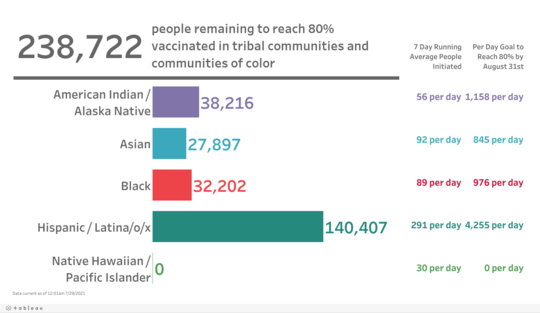 Additional Brief Updates
- In an effort to reduce the number of those who have yet to be vaccinated, President Biden announced today that federal civilian employees will be required to be vaccinated or receive weekly COVID testing. The Pentagon is expected to extend the same requirement to all military personnel. Here's reporting from the New York Times.
- Portland Mayor Ted Wheeler announced yesterday that he will be asking his City Council colleagues to develop a requirement similar to the one that President Biden announced today—that all city employees need to be vaccinated or be tested for COVID each week. Here's more.
- New research is showing that the Delta virus—unlike previous versions--can be spread by those who have already been vaccinated. It appears that once it gets into the bloodstream, it is generally attacked by antibodies produced as a result of vaccination. But those that remain in the nose (and the Delta variant reproduces there in great number) can easily be shared—though less easily if the individual with them is wearing a mask. Hence, renewed calls for people whether vaccinated or not, to return to wearing face coverings when in close proximity to others. Here's more.
- Here’s reporting on that same subject from the Washington Post, with a focus on the CDC’s response to this new evidence of the virulence of the Delta variant. Based on this new evidence, there is a growing sense of urgency and fear in the agency about the effects of the new variant.
- The New York Times had a piece earlier i the week around the confusion that resulted from the CDC’s announcement of its revised masking recommendations. In it you can see the CDC’s county-level infection-rate map allowing us to see where it was recommending that masks be worn in public indoor spaces. (Infection rates in Multnomah and Washington Counties were low enough not to be included.)
-
The Atlantic’s science writer, Katherine Wu, makes the case for reinstating masking requirements.
- Amid evidence that vaccines may be less effective among older people and that a third booster shot may be beneficial in the face of the Delta variant, Israel has just announced a plan to give seniors over the age of 60 a third dose of the Pfizer vaccine.This is still being considered here in the U.S., particularly for individuals who are immune-compromised.
- Amidst the return of masking recommendations and mandates, it was inevitable that there would be considerable pushback from a variety of sources. It was also inevitable that much of it would be directed at Dr. Fauci and would come in the form of misleading information on social and other media. .Here's more.
- The New York Times had a story earlier this week around a single individual responsible for much of the misinformation in social media regarding COVID vaccines: Joseph Mercola.. He has also managed to profit personally from this misinformation.
- OPB’s Amelia Templeton provides some Q & A's on the Delta variant in Oregon.
- Sunday’s New York Times Magazine had a story about those who were vaccine-hesitant for a long time, but eventually decided the time was right.
- Nevertheless, the Associated Press reports that most of the unvaccinated do not want a shot.
- Moving finally to a non-COVID subject, the federal Consumer Financial Protection Bureau (CFPB) has sent legislators a new resource to help those who need rental assistance. Here it is.
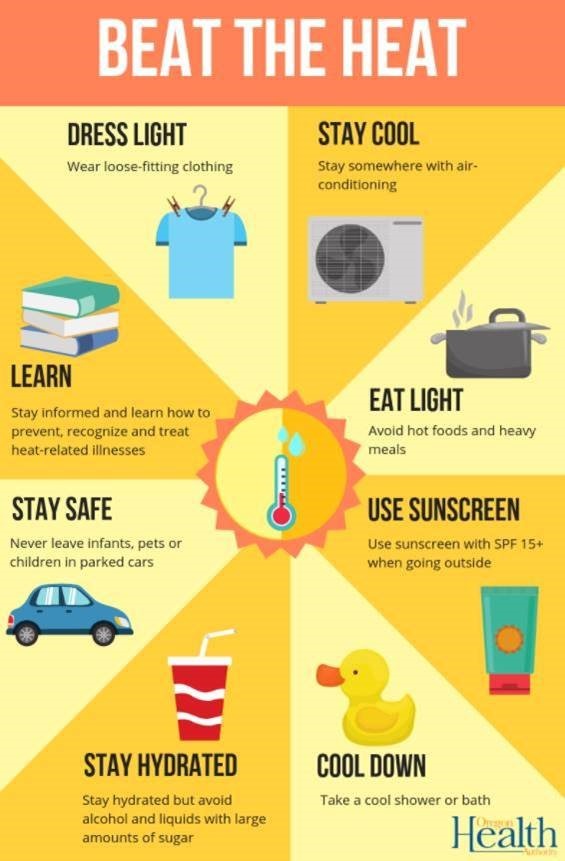 Heat Crisis Returns
As you know, we find ourselves the middle of another heat crisis—overall not as bad as the last one, but dangerous for many nonetheless, with temperatures predicted to approach triple digits in the Portland area tomorrow and 106 degrees in Southern Oregon. It’s important that we learn the lessons from tragedies of a month ago.
The Oregon Office of Emergency Management has just released a review of those lessons. Here's a press release that was sent to legislators, containing a link to the complete After-Action Review. Among its recommendations for improved response were the following:
- Increased and earlier health information sharing with local leadership.
- Ensuring 211 is resourced to provide 24/7 coverage to respond to inquiries and requests for assistance.
- Ongoing conversations with local partners to waive public transit fares during extreme heat events.
- Prioritizing the importance of readiness for Oregonians and communicating the importance of checking on neighbors, relatives and coworkers.
Our 211 (by phone or 211info.org via the internet) support system had been charged with providing information about cooling centers and how to access them, but at the time it was not operational on the weekends. That has changed, and it will be available at all times now. In addition, here in the Portland area, if temperatures hit triple digits, Tri-Met will take people to cooling centers free of charge.
The Governor has declared a heat emergency in 23 of Oregon’s 36 counties. You’ll find her declaration statement here.
Here’s message with a number of resources that was just sent to us from OHA:
Senators and Representatives:
We are expecting extreme heat beginning today and lasting over the weekend. Governor Kate Brown declared a state of emergency in 22 counties to ensure additional resources are available and I have attached the emergency declaration.
211 will be available to Oregonians for help with heat-related resources, including locating a cooling center. All Oregon counties have been asked to send cooling center information to 211 for inclusion on the website, which is available in seven languages: https://www.211info.org/coolingcenters. Here is a list of additional resources for you and your constituents:
And here are cooling centers and other resources in Multnomah County.
Another change that has occurred in the last month is that Oregon OSHA has issued its new emergency rulesfor extreme heat. Those rules are now in force. Since temperatures in the fields are now above 90 degrees, the high heat rules apply. The rules do also apply to indoor work.
Finally, I do want to stress the importance of the final bullet item in the list above—please do keep an eye out for neighbors, friends, coworkers, and relatives. Make sure they have what they need. I know that many community organizations and health outreach workers are going to be extra vigilant about outreach to the best of their abilities, but it will take all of us to do what we can to help others stay safe.
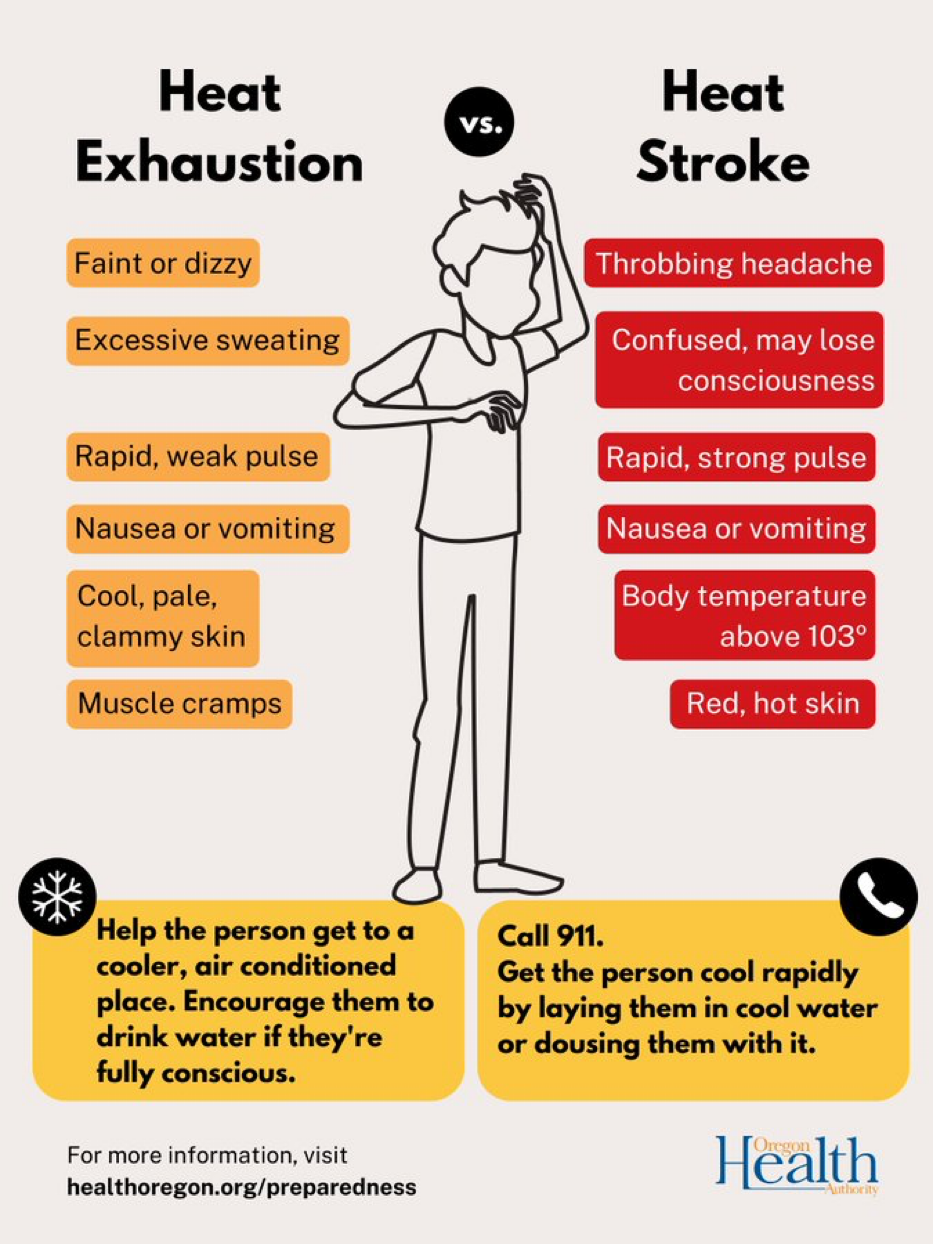
Masking Will Be Required in Schools This Fall
We all obviously hoped it wouldn’t be necessary, but for now it is clear that kids, teachers, and everyone else coming into a school this fall will need to wear a face covering. The Governor has directed the Department of Education and the Oregon Health Authority to develop rules to clarify the requirement and identify necessary exceptions. You can read her order here.
The order was issued just this morning, but frankly the way things have been going, it seemed inevitable. With the rising case numbers, the growing understanding of how infectious the new Delta variant is, how it can be shared even when an individual has been vaccinated and/or is not showing any symptoms, with the fact that no children under 12 can yet be vaccinated and many of those 12 and over have yet to be vaccinated, it is a necessary precaution—at least for now. If things change dramatically over the next month or two, we can expect to see the requirement go away.
This decision of the Governor’s will be controversial (I'm already receiving emails in opposition), but it’s one that I as a legislator and Chair of the Senate Education Committee do support. I’ll be working with the Department of Education to make sure that the rules for the fall are appropriate and science-based.
For mre information about the decision, here's reporting from the Statesman-Journal .and from the Oregonian.
Wildfire Update: Improved But Still Dangerous
Legislators were briefed on Tuesday about the current state of wildfire here in Oregon. Thanks to the incredible work of thousands of firefighters from around Oregon and many parts of the country (and some help from Mother Nature in the form of moisture), the huge lightning-caused Bootleg Fire in Klamath and Lake Counties is now 53% contained, but not before having burned 413,400 acres so far. The other big recent fires have been the Elbow Creek Fire in Wallowa County (22,900 acres, 50% contained) and the Jack Fire in Douglas County, east of Glide (22,244 acres burned, 61% contained).
So far this year, ODF and the State Fire Marshal have had to deal with more than 1,000 fires, with more than 500,000 acres burned. Costs of fighting these fires have already exceeded $62 million (fortunately, more than $37.6 million of that amount qualifies for federal reimbursement). We are already far above our ten-year average for acres burned, and we haven’t yet entered the peak season for wildfire on the western side of the Cascades: August and September. The combination of drought, historically dry timber, and historically high temperatures puts us at great risk as a state.
Adding to the difficulties faced by the firefighters is the risk of COVID-19 in the fire camps. There have already been a number of positive cases, and COVID protocols, including masking and distancing, have had to be reinstated.
Here’s a write-up from ODF on Tuesday’s legislative briefing.
You can follow the situation on a daily basis via the ODF blog. https://odffire.com/
2021 Legislative Session in the Rearview Mirror: Long-Awaited Investments in Mental/Behavioral Health
I think most of us understand the high price that we’ve paid for inadequate investment in treatment and other resources to help those struggling with mental health and addiction challenges. That was one of the reasons that the voters passed Measure 110 in November, charging the Legislature with decriminalizing additional drug offenses and creating new support systems to help those who are ready to be helped. As I reported in the lookback at our Criminal Justice/Public Safety legislation, we did successfully create the implementation of that ballot measure via SB 755, which will involve $200 million in funding.
I’m also very pleased to report that the Legislature also took advantage of our positive budget situation and additional support from the federal government to make some historic new investments in behavioral health to the tune of $350 million. They also involve changes that should make the process of seeking assistance simpler, more transparent, and easier to navigate. Here's a summary of the relevant bills from the Ways and Means Human Services Co-Chairs, Senator Kate Lieber and Representative Rob Nosse.
There is of course much that still needs to be done, and we need to make sure that these new investments are used effectively.
Please let me know if you have any questions about these bills.
OHA Releases Latest County Metrics
Though it’s no longer assigning risk levels to counties, OHA is still reporting weekly increases/decreases in COVID spread for each county and for the state as a whole. Not surprisingly, we are again seeing increases in COVID infection rates and positivity rates in nearly every county and in the state as a whole. The rates in the Tri-County Portland area are creeping up, but they still remain relatively low; we’re again seeing big increases in the rural counties. Most striking is Umatilla County (the Pendleton and Hermiston area), where vaccination rates unfortunately remain relatively low.
Weekly COVID Data and Outbreaks Report Released: Ongoing Increases
The Oregon Health Authority’s COVID-19 Weekly Report, released yesterday, shows an increase in daily cases and hospitalizations and a decline in COVID-19 related deaths. Unfortunately, we cannot take any solace in the reduction in deaths: that’s just a function of the fact that last week’s numbers were inflated because they included the reporting of deaths that had actually occurred many weeks or months ago but the paperwork was just catching up. With the increasing numbers of hospitalizations, we must be prepared for an increase in deaths in the near future. Again, they will almost all be among those unvaccinated against COVID-19.
- OHA reported 3,098 new daily cases of COVID-19 during the week of Monday, July 19, through Sunday, July 25. That represents a 53% rise over the previous week.
- New COVID-19 related hospitalizations rose to 146, up from 123 the previous week.
- There were 12 reported COVID-19 related deaths, down from 29 reported the previous week. (Mainly due to reporting anomalies.)
- There were 54,566 tests for COVID-19 for the week of July 18 through July 24. This is a 12% decline from the 62,098 tests reported the previous week.
- Test positivity rose again, from 4.2% to 5.0%.
- As of July 27, 2,477,608 Oregonians — 58.1% of the state’s total population — had received a least one dose of COVID-19 vaccine. This is an increase of 0.6% from the previous week.
- Again, case rates have generally been higher in counties with lower COVID-19 vaccination rates. During the week of July 18–25, the 10 counties with case rates in excess of 100 per 100,000 had population vaccination rates below 50%.
Today’s COVID-19 Weekly Outbreak Report shows 28 active COVID-19 outbreaks in senior living communities and congregate living settings. As you can see below, this is the largest number since mid-May:
1/13/21 202 facilities
2/10/21 116 facilities
3/10/21 44 facilities
4/14/21 24 facilities
5/12/21 42 facilities
6/09/21 19 facilities
6/16/21 22 facilities
6/23/21 21 facilities
6/30/21 21 facilities
7/8/21 22 facilities
7/14/21 21 facilities
7/21/21 21 facilities
7/28/21 28 facilities
The Outbreak Report also includes the latest data on COVID in workplaces, childcare centers, and public and private K-12 schools.
And the Deaths:
Here is information about the 21 deaths (down from 21) that OHA has reported since the last newsletter on July 22.
Oregon’s 2,835th COVID-19 death is a 66-year-old man from Yamhill County who tested positive on July 9 and died on July 21 at Legacy Good Samaritan Medical Center.
Oregon’s 2,836th COVID-19 death is a 46-year-old woman from Tillamook County who tested positive on July 7 and died on July 9 at her residence.
Oregon’s 2,837th COVID-19 death is a 69-year-old man from Clackamas County who tested positive on July 8 and died on July 23 at Legacy Meridian Park Medical Center.
Oregon’s 2,838th COVID-19 death is an 85-year-old man from Multnomah county who tested positive on July 12 and died on July 23 at Legacy Meridian Park Medical Center.
Oregon’s 2,839th COVID-19 death is an 87-year-old woman from Lane County who tested positive on July 22 and died on July 24 at McKenzie-Willamette Medical Center.
Oregon’s 2,840th COVID-19 death is an 84-year-old man from Lane County who tested positive on July 12 and died on July 23 at McKenzie-Willamette Medical Center.
Oregon’s 2,841st COVID-19 death is a 95-year-old woman from Marion County who tested positive on July 16 and died on July 25 at Salem Hospital.
Oregon’s 2,842nd COVID-19 death is a 58-year-old man from Polk County who tested positive on July 15 and died on July 24 at Salem Hospital.
Oregon’s 2,843rd COVID-19 death is a 90-year-old man from Josephine County who tested positive on July 15 and died on July 25 at Asante Three Rivers Medical Center.
Oregon’s 2,844th COVID-19 death is an 81-year-old woman from Lane County who tested positive on June 26 and died on July 25 at Peacehealth Sacred Heart Medical Center at Riverbend.
Oregon’s 2,845th COVID-19 death is a 95-year-old woman from Jackson County who tested positive on June 5 and died on June 18 at Providence Medford Medical Center. \
Oregon’s 2,846th COVID-19 death is a 99-year-old woman from Jackson County who tested positive on May 7 and died on July 6 at her residence.
Oregon’s 2,847th COVID-19 death is a 37-year-old woman from Washington County who tested positive on July 25 and died on July 25 at her residence.
Oregon’s 2,848th COVID-19 death is a 33-year-old man from Umatilla County who tested positive on July 24 and died on July 24 at Kadlec Regional Medical Center.
Oregon’s 2,849th COVID-19 death is a 90-year-old woman from Umatilla county who tested positive on July 23 and died on July 27.
Oregon’s 2,850th death is an 80-year-old man from Jackson County who tested positive on July 21 and died on July 27 at his residence.
Oregon’s 2,851st death is an 83-year-old man from Jackson County who tested positive on July 16 and died on July 28 at his residence.
Oregon’s 2,852nd death is a 63-year-old woman from Douglas County who tested positive on July 15 and died on July 27 at Peacehealth Sacred Heart Medical Center at Riverbend.
Oregon’s 2,853rd death is a 48-year-old man from Marion County who tested positive on Sept. 14, 2020 and died on Sept. 21, 2020 at Integris Baptist Medical Center.
Oregon’s 2,854th death is a 67-year-old woman from Marion County who tested positive on July 11 and died on July 25 at Providence St. Vincent Medical Center.
Oregon’s 2,855th death is an 85-year-old woman from Linn County who tested positive on July 12 and died on July 24 at Good Samaritan Regional Medical Center.
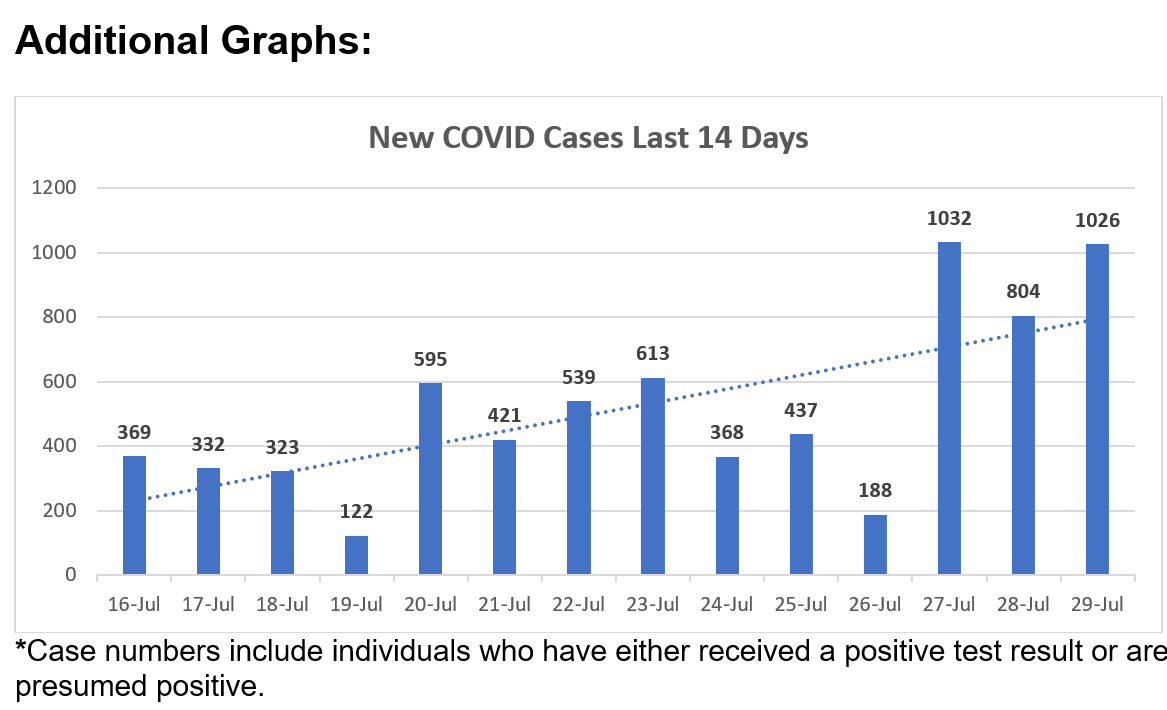
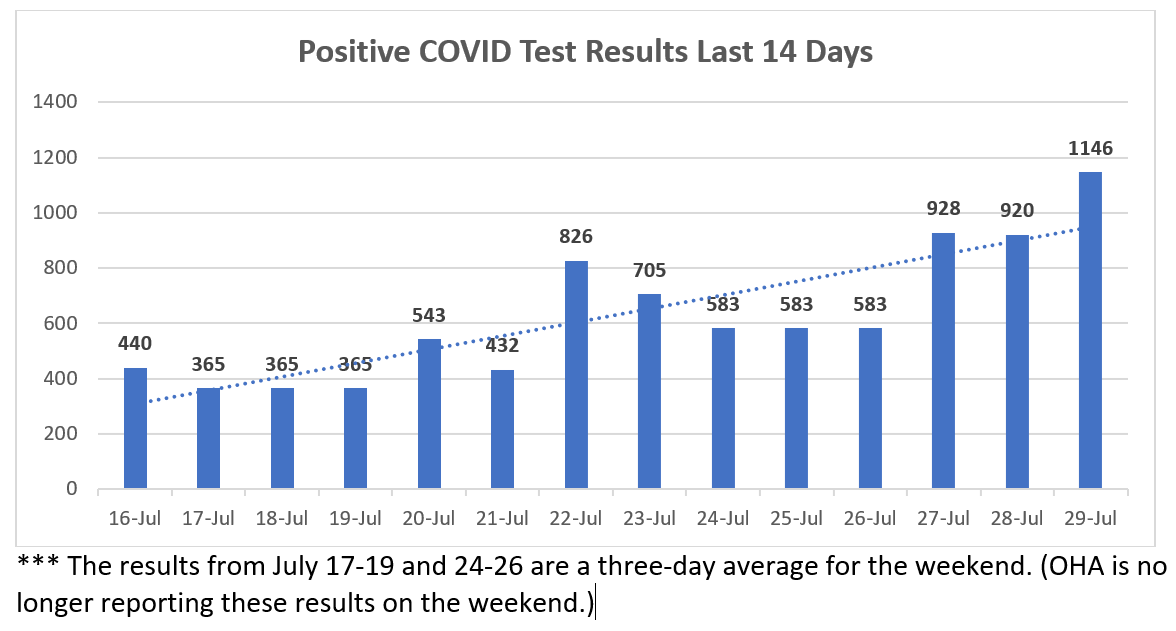
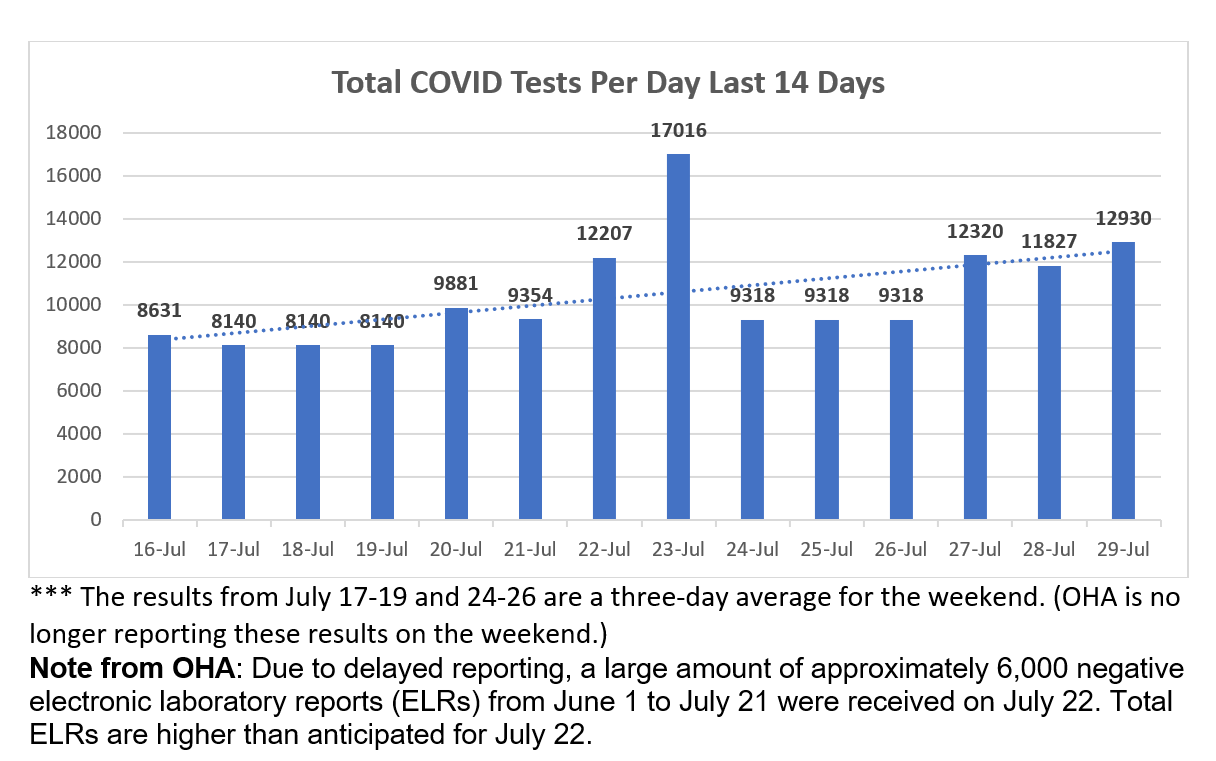
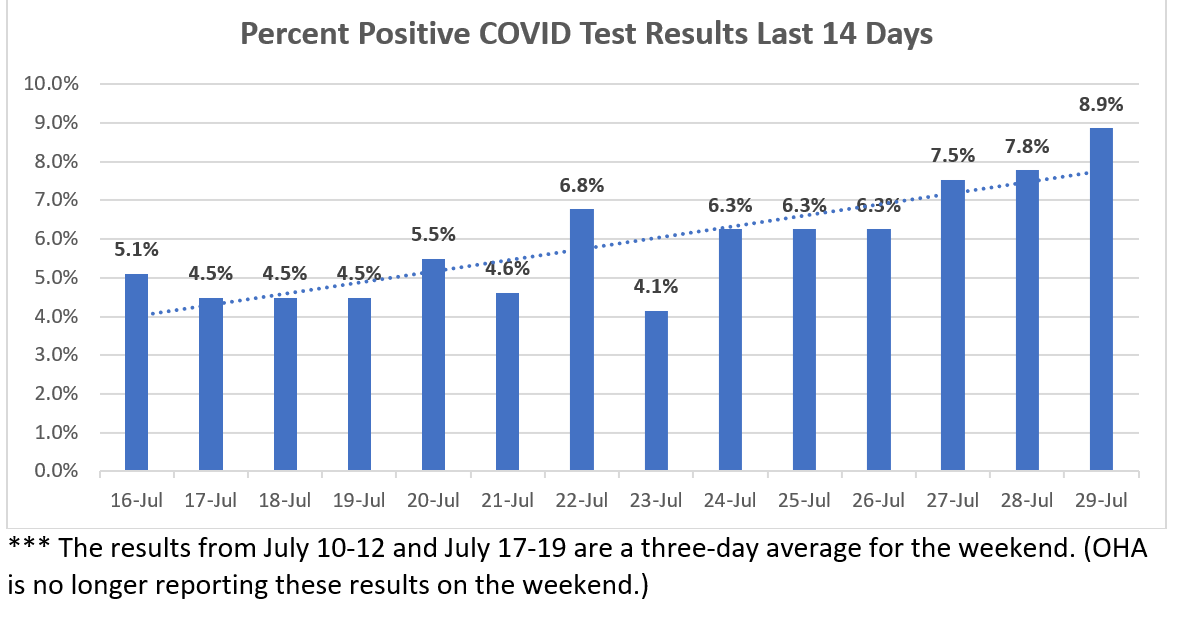

Want to See Past Newsletters?
If there was COVID-related information in a past newsletter that you want to go back to, but find you’ve deleted it, you can always go to my legislative website (senatordembrow.com), click on “News and Information,” and you’ll find them all there. Also, if someone forwarded you this newsletter and you’d like to get it directly, you can sign up for it there.
AND FINALLY,
Here again are some resources that you will find useful
If the above links are not providing you with answers to your questions or directing you to the help that you need, please consider me and my office to be a resource. We’ll do our best to assist you or steer you in the right direction.
Best,
 Senator Michael Dembrow
District 23
email: Sen.MichaelDembrow@oregonlegislature.gov
web: www.senatordembrow.com
phone: 503-281-0608
mail: 900 Court St NE, S-407, Salem, OR, 97301
|